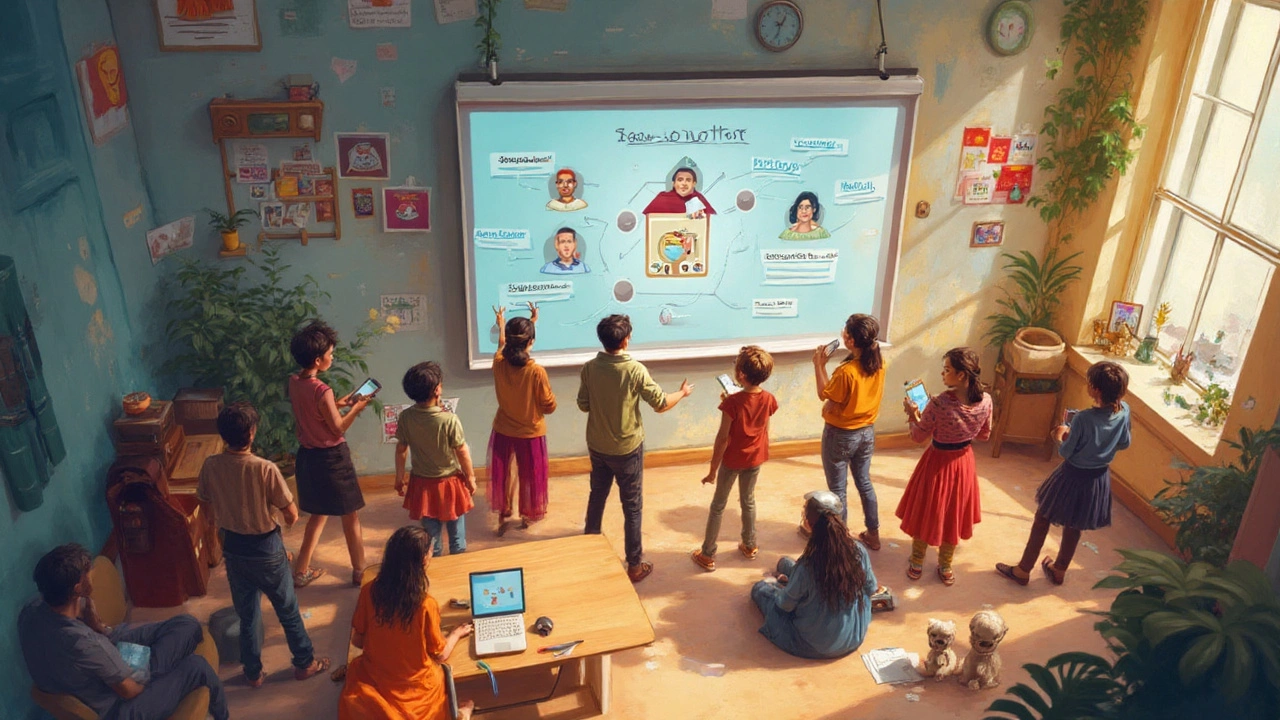
If you tried searching for a book at a library in the '90s, you probably remember the clumsy card catalogs and the endless aisles. These days, you just need a device and a web connection. Instantly, you can join a class, buy a shirt, or chat with a friend in another country. That’s the world of e-platforms. Chances are, you already use an e-platform every day—sometimes without even thinking twice about it. But what exactly is an e-platform, and how deep does this digital rabbit hole go?
Breaking Down the Basics: What Is an E-Platform?
Let’s make this simple. An e-platform (aka electronic platform) is any digital space where users interact, exchange ideas, share resources, or transact business. Think of it as a virtual meeting place, a marketplace, or a classroom—except nobody is dragging chairs around. Anywhere digital activity happens between people or groups, you’ll probably find an e-platform driving it. Amazon is an e-platform. So is Zoom. So is your favorite online bank, and definitely the app you use to binge TV shows. Schools even use special e-learning platforms to keep classes running beyond brick walls.
Here’s the kicker: e-platforms aren’t just websites. They’re entire ecosystems. The tech runs deep: from the databases that remember who you are, to the security systems that keep your info safe, to all the features that let you chat, upload, post, stream, sell, buy, or just scroll. Modern e-platforms support millions of users at once. The scale is mind-blowing—Facebook had over 2.9 billion active users in 2024 alone (yep, the population of China and India combined!).
What sets an e-platform apart from a regular website? Interaction. If you fill out a form, upload homework, or trade messages, you’re engaging with a platform—not a static webpage. Behind the scenes, these platforms are buzzing with updates, keeping everything up to speed in real-time. E-platforms run 24/7. There’s no closing time.
Some platforms are massive, serving millions globally. Others are built for a handful—say, a professor’s private chemistry course. But they share core traits: user accounts, digital content, an interface to navigate (sometimes pretty, sometimes not), and tools for feedback (ratings, comments, or likes). It’s these shared basics that let platforms power everything from international trade to homework assignments.
Key Features All E-Platforms Share
So what do all e-platforms have in common? First up, accounts. You’ll almost always need a username and password, sometimes even two-factor authentication. Why? To keep things safe, track your stuff, and let you pick up where you left off. The second feature is access—a nicely designed portal that lets you log in, upload content, chat, download files, or shop. It doesn’t matter if it’s an art community or your bank account; ease of use is king.
Content is the third big one. This could mean videos, PDF guides, products for sale, or live lectures. On e-learning sites like Coursera and Khan Academy, this means tutorials, quizzes, and progress reports. On a retail giant like Amazon, it means millions of product listings, reviews from actual shoppers, and smart suggestions (those “people also bought” lines are pure algorithm magic). The content has to be organized and searchable—try finding a soup recipe among 6 million options if things aren’t carefully tagged.
Fourth? Community and communications. E-platforms thrive on conversations—between buyers and sellers, tutors and students, old friends or new collaborators. Messaging, comments, group forums, or live chats are baked right in. Without the people part, you’re back to those old static websites.
There’s also payment and security, a layer that most people don’t see but is always running in the background. Buying something through a platform means encryption and digital payment processing: credit cards, UPI, PayPal, cryptocurrency—take your pick. If you noticed your favorite platform asking for an SMS code before you log in, that’s no accident; security is serious business, especially when personal data is involved.
One fun fact: the biggest e-platform out there (measured by daily active users) is actually WhatsApp, not Facebook itself. That should tell you how essential digital connectivity has become. Platforms have made it so that just about anything—learning, business, fun—can spin out of thin air in digital form.

Types of E-Platforms and Real-World Uses
It’s wild how many kinds of e-platforms exist today. Shopping, learning, earning, dating, socializing—you name it. But you can break them down into five big groups: e-learning platforms, e-commerce platforms, social platforms, work/collaboration platforms, and special-purpose platforms.
- E-learning platforms like Udemy, Coursera, and Byju’s have taken off since the pandemic. In India alone, the online education market jumped by over 45% from 2022 to 2024. These platforms offer everything from basic math to high-level programming, often with quizzes, discussion boards, and downloadable certificates.
- E-commerce platforms—think Amazon, Flipkart, and Etsy—let you buy and sell pretty much anything. Sellers get tools to manage products and track sales. Buyers get smooth payment options and real reviews. As of August 2025, more people in India buy groceries online each week than go to physical markets.
- Social media platforms like Instagram, Twitter (now called X), and LinkedIn aren’t just for sharing selfies. They're vital for job hunting, networking, and real-time news. Some, like Reddit, are more niche, with tight-knit communities discussing everything under the sun.
- Work and collaboration platforms have made ‘remote office’ a real thing. Microsoft Teams, Slack, and Google Workspace let you chat, meet, and create documents together, even if your team spans continents.
- Finally, there are special-purpose platforms. Dating apps, banking platforms, stock trading sites, crowdfunding hubs—each built for a targeted need. Even government portals for voter ID or PAN services are e-platforms in disguise.
Pretty much every sector has jumped onto the e-platform bandwagon. Banks now offer online-only savings accounts. Teachers assign essays through Google Classroom or Edmodo. Sports clubs run membership and events through private apps. Even doctors and patients connect through medical e-platforms, handling appointments, test results, and virtual consultations.
Here’s the wild part—platforms never stand still. A study by Statista showed the number of global e-platform users grew from 4.3 billion in 2023 to 5.1 billion in 2025. That’s nearly two out of every three people on Earth. Everyone’s online, and the platforms are getting smarter, more personal, and way more useful by the month.
How to Pick the Right E-Platform for Your Needs
Feeling a bit overwhelmed? With thousands of options, it’s tempting to just stick to what you know. But choosing the right e-platform can really boost your learning, work, shopping, or social life. Here’s what you need to ask yourself.
- What’s your end goal? If you want to learn coding, try something like Codecademy or Coursera. If you’re looking to freelance, Upwork or Fiverr are where most pros get started.
- Does it work for your device? Not all platforms are fully mobile-friendly. Check the app or site on your phone before signing up.
- Is it easy to use? Life’s too short to deal with clunky layouts. Platforms like Zoom and Amazon are popular not just for features, but for their simplicity.
- What about support and safety? Always look for platforms with clear customer support, robust privacy policies, and secure payment (check for the padlock symbol in your browser).
- Ratings and reviews—don’t skip these. Most platforms show off testimonials and ratings. Real feedback tells you what’s great and what’s just hype.
Not happy after signing up? No shame in switching. Most people use at least five major *e-platforms* daily, swapping as their needs change. Take Zoom's rise in 2020—nobody had heard of it, then every school and workplace was meeting on it by April. The perfect platform for your needs today might not even exist yet—it could pop up by next year.

The Road Ahead: What’s Next for E-Platforms?
Tech doesn’t slow down. In 2025, AI is already guiding what we see, what we buy, and even what we study. E-platforms use algorithms to tailor your experience—YouTube suggests new videos, LinkedIn recommends job openings, Amazon nudges you with similar gadgets. Platforms are rapidly adding voice controls, AR, and even VR features (Meta’s Horizon Worlds, for example, blends social media and gaming into virtual reality).
There’s also a growing push for open e-platforms, where users and creators set the rules—not just corporate giants. Open-source e-learning software like Moodle is a big hit among universities that want full control. Platforms are starting to connect better with each other, too—connecting your Google account to dozens of apps, or using a payment wallet everywhere.
But not everything is sunshine and roses. Data privacy is a huge worry. Big hacks, breaches, and online scams have made headlines in the past year—prompting new laws in India, the EU, and even the US. The best tip? Don’t overshare. Use strong passwords. Understand the platform’s privacy settings and stick to trusted payment options. The responsibility isn’t just on the companies—it’s on users, too.
If you want to get ahead, start treating e-platforms as essential life tools. They aren’t just for scrolling or shopping—they’re your gateway to learning new skills or making connections that never would’ve been possible offline. Whether you’re a student, teacher, business owner, freelancer, or just curious, there’s an e-platform out there waiting to open new doors. The real magic happens when you learn to explore and make smarter choices with every click.





